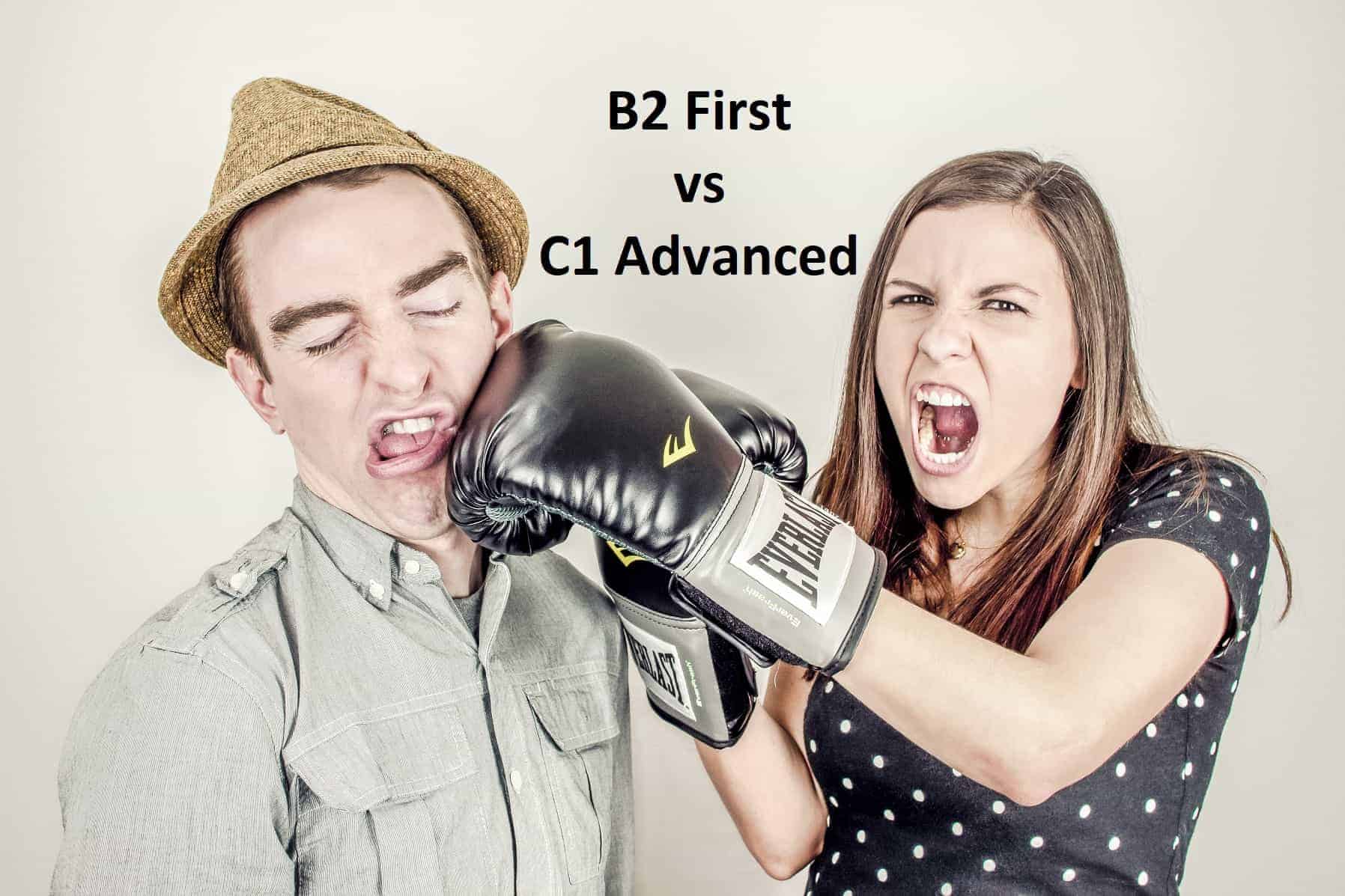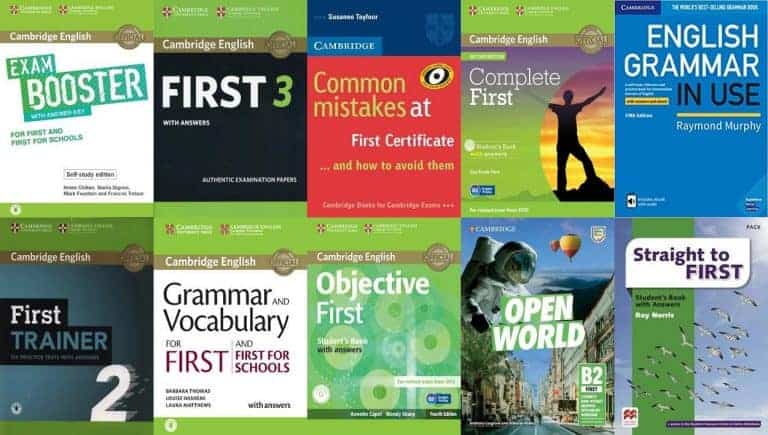B2 First (FCE) vs. C1 Advanced (CAE)
Cambridge B2 First (formerly known as FCE) and C1 Advanced (CAE) are two English language examinations designed and administered by Cambridge Assessment at the University of Cambridge. While passing B2 First is equivalent to CEFR level B2, C1 Advanced indicates a higher level at C1. Both exams can be taken in a paper-based or computer-based version.
How are B2 First (FCE) and C1 Advanced (CAE) similar?
Even though the two exams fall on different levels on the CEFR scale, there are a lot of similarities like the structure of the exams, delivery methods, the marking system as well as how the results are reported. After all, they are both parts of a sequence of exams that Cambridge carefully designed so each test builds on the previous one.
In this article, I’m going to focus on the similarities and differences between B2 First and C1 Advanced, but if you are interested in finding out more about the two tests, you can follow the two links to my detailed articles below.
>>> Everything you need to know about B2 First (FCE) <<<
>>> Everything you need to know about C1 Advanced (CAE) <<<
Exam structure
The first major similarity between B2 First and C1 Advanced lies in the way the exams are structured. We find five different parts called papers which test different aspects of a candidate’s English language skills.
In both exams, the papers are as follows:
- Reading & Use of English (grammar and vocabulary)
- Listening
- Speaking
- Writing
As you can see, all the bases are covered. While Use of English tests one’s grammar and vocabulary, the other papers look at receptive (reading and listening) as well as productive (speaking and writing) skills.
Delivery methods
Cambridge offers the exam in two different ways of delivery. Firstly, there is the paper-based version which is still the more commonly taken one, and then there is the computer-based version.
Apart from the fact that one version is done on paper and the other one at a computer, there isn’t really any difference between the two. You go through the same papers (Reading & Use of English, Listening, Speaking and Writing) and even the tasks and questions are exactly the same.
It is completely up to you which of the two you prefer, but there are still a lot more centres that only offer the paper-based exam so you will have to look specifically for the computer-based test if you would like to go down this route.
Below you can see a tutorial video about the computer-based B2 First exam, but it is really the same for C1 Advanced as well.
Marking system
Another clear similarity is the way the tests are marked. Your correct answers are added up and converted to a score which tells you if you’ve passed that paper or not.
Obviously, there are small differences between B2 First and C1 Advanced in the number of questions and some of the tasks (Continue reading if you want to find out more about this.), but the basic idea is the same.
If you want to know more about how exactly all of this works, you can follow the two links below. In those articles, I go into a lot of detail about the marking system and how exactly you can figure out your score.
>>> How to calculate your score in B2 First <<<
>>> How to calculate your score in C1 Advanced <<<
Reporting of results
The last similarity between B2 First and C1 Advanced lies in the way your results are reported to you. In order to get your score the examiner has to add up all your correct answer and then converts everything to a score that falls somewhere on the Cambridge Scale.
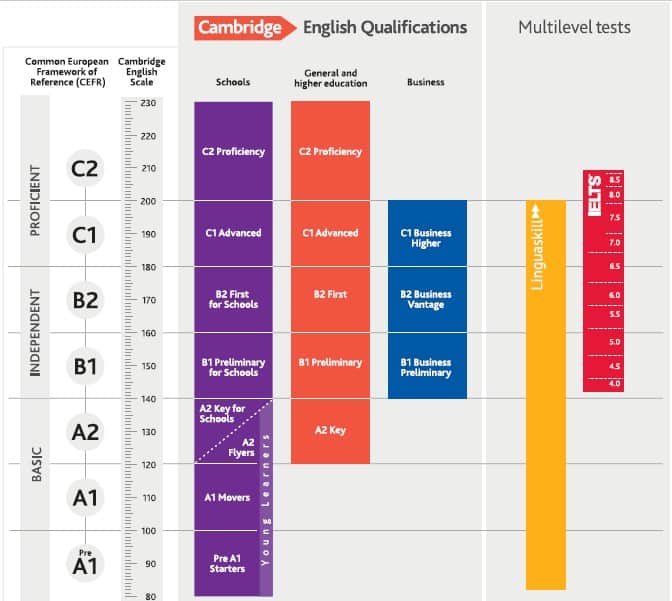
The red bar in the middle of the image shows you the different levels along the Cambridge Scale. B2 First falls between 160 and 180 while C1 Advanced is higher (180-200).
When you receive your results, you always get a score for each of the five exam papers as well as an overall score. The example below is for C1 Advanced, but it pretty much looks the same for B2 First.
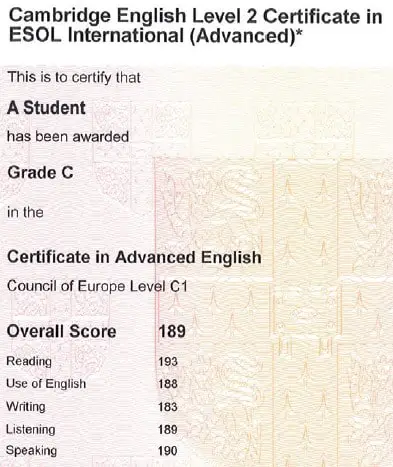
How are B2 First (FCE) and C1 Advanced (CAE) different?
While there are quite a few similarities between the two tests, there are also a bunch of differences. After all, there are two separate exams for a reason.
When we look at the things that distinguish the two, we need to consider the levels of English that each exam tests, the differences in the tasks, the timing and the variants the exams do or don’t come in.
Level
The biggest difference is, without a doubt, the levels that are tested in B2 First and C1 Advanced. In Europe, there is a common framework which is widely accepted as the measuring stick for someone’s English level.
In this framework, we find six different levels: A1, A2, B1, B2, C1 and C2. You can immediately see that B2 and C1 are in the top half of levels, but while B2 is described as being an independent user of English, C1 falls in the category of proficiency. If you want to get a more detailed description of what the different levels mean and what someone at that level is able to do with their English, you can go to the website of the Council of Europe and check out the official level descriptors.
Scoring
Because the exams are not at the same level but placed on the same scoring scale it is probably worth looking at how exactly the different exam papers are scored. Below you can find a nice image that shows you what the marks you earn in either exam are worth in terms of the score on the Cambridge Scale as well as the equivalent CEFR level.
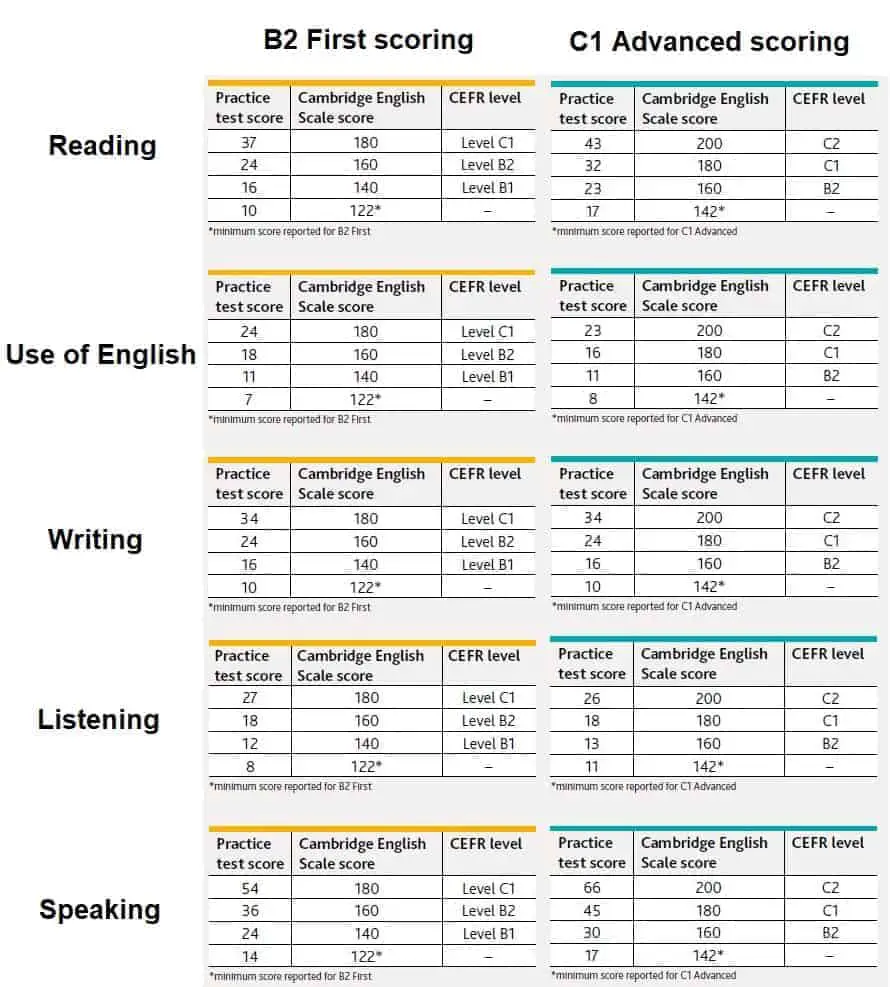
Note that a really high test score in B2 First can get you to CEFR level C1 so with a great result you can actually achieve a higher level than the exam suggests. Great news for you. 🙂
Tasks
Even though the exams are very similar when it comes to the design of the tasks, there are still a few differences. For example, in B2 First there are seven tasks in Reading & Use of English while in C1 Advanced we find eight. Also, in Writing, Listening and Speaking, you will notice differences in task types and/or order so it is crucial to study the design of both tests before signing up to any of them.
I have written two separate articles on all the different task types in the two tests so if you want to find out what exactly is going on with all of it, just follow the two links below.
>>> Everything you need to know about the tasks in B2 First <<<
>>> Everything you need to know about the tasks in C1 Advanced <<<
Timing
As mentioned above, the two exams are not designed the same with differences in task types and order of tasks. For this reason, the timings of the five exam papers vary between B2 First and C1 Advanced.
| Task timings | ||
| B2 First | C1 Advanced | |
| Reading & Use of English | 75 minutes | 90 minutes |
| Writing | 80 minutes | 90 minutes |
| Listening | around 40 minutes | around 40 minutes |
| Speaking | 14 minutes | 15 minutes |
Variants
Last but not least, B2 First comes in three variants while C1 Advanced only has two. First of all, there is a regular as well as a business version of both exams, but only B2 First comes with a test specifically designed for school children and teenagers.
The task types and timings are exactly the same as in the ‘normal’ test, but the topics and questions are designed to fit the interests and everyday life of children and teenagers rather than adults, which is a great addition to the portfolio and I can say from my own experience as a teacher that younger learners appreciate it when they are not asked about a job they don’t have or their university studies when they are still in high school.
And now what?
I hope this article helps you to better understand the differences between B2 First and C1 Advanced. Both exams can be extremely valuable, especially if you have to show proof of your English level for education or work purposes.
Do your homework and check what exactly you need to do so you can make an informed decision.
Lots of love,
Teacher Phill 🙂

